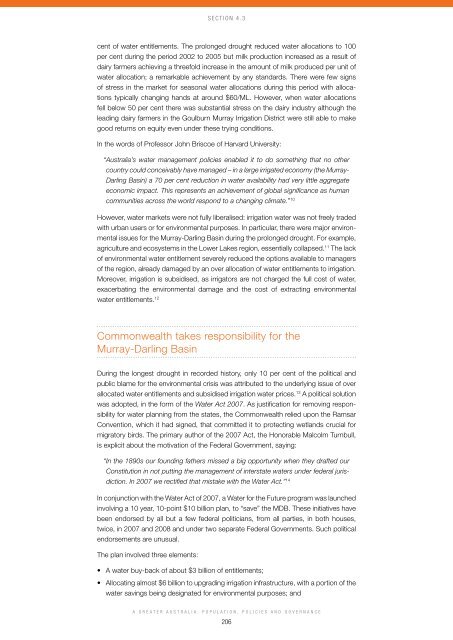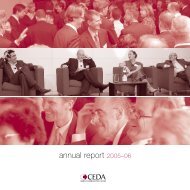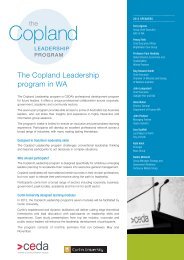A Greater Australia: Population, policies and governance - CEDA
A Greater Australia: Population, policies and governance - CEDA
A Greater Australia: Population, policies and governance - CEDA
- No tags were found...
Create successful ePaper yourself
Turn your PDF publications into a flip-book with our unique Google optimized e-Paper software.
Section 4.3cent of water entitlements. The prolonged drought reduced water allocations to 100per cent during the period 2002 to 2005 but milk production increased as a result ofdairy farmers achieving a threefold increase in the amount of milk produced per unit ofwater allocation; a remarkable achievement by any st<strong>and</strong>ards. There were few signsof stress in the market for seasonal water allocations during this period with allocationstypically changing h<strong>and</strong>s at around $60/ML. However, when water allocationsfell below 50 per cent there was substantial stress on the dairy industry although theleading dairy farmers in the Goulburn Murray Irrigation District were still able to makegood returns on equity even under these trying conditions.In the words of Professor John Briscoe of Harvard University:“<strong>Australia</strong>’s water management <strong>policies</strong> enabled it to do something that no othercountry could conceivably have managed – in a large irrigated economy (the Murray-Darling Basin) a 70 per cent reduction in water availability had very little aggregateeconomic impact. This represents an achievement of global significance as humancommunities across the world respond to a changing climate.” 10However, water markets were not fully liberalised: irrigation water was not freely tradedwith urban users or for environmental purposes. In particular, there were major environmentalissues for the Murray-Darling Basin during the prolonged drought. For example,agriculture <strong>and</strong> ecosystems in the Lower Lakes region, essentially collapsed. 11 The lackof environmental water entitlement severely reduced the options available to managersof the region, already damaged by an over allocation of water entitlements to irrigation.Moreover, irrigation is subsidised, as irrigators are not charged the full cost of water,exacerbating the environmental damage <strong>and</strong> the cost of extracting environmentalwater entitlements. 12Commonwealth takes responsibility for theMurray-Darling BasinDuring the longest drought in recorded history, only 10 per cent of the political <strong>and</strong>public blame for the environmental crisis was attributed to the underlying issue of overallocated water entitlements <strong>and</strong> subsidised irrigation water prices. 13 A political solutionwas adopted, in the form of the Water Act 2007. As justification for removing responsibilityfor water planning from the states, the Commonwealth relied upon the RamsarConvention, which it had signed, that committed it to protecting wetl<strong>and</strong>s crucial formigratory birds. The primary author of the 2007 Act, the Honorable Malcolm Turnbull,is explicit about the motivation of the Federal Government, saying:“In the 1890s our founding fathers missed a big opportunity when they drafted ourConstitution in not putting the management of interstate waters under federal jurisdiction.In 2007 we rectified that mistake with the Water Act.” 14In conjunction with the Water Act of 2007, a Water for the Future program was launchedinvolving a 10 year, 10-point $10 billion plan, to “save” the MDB. These initiatives havebeen endorsed by all but a few federal politicians, from all parties, in both houses,twice, in 2007 <strong>and</strong> 2008 <strong>and</strong> under two separate Federal Governments. Such politicalendorsements are unusual.The plan involved three elements:• A water buy-back of about $3 billion of entitlements;• Allocating almost $6 billion to upgrading irrigation infrastructure, with a portion of thewater savings being designated for environmental purposes; <strong>and</strong>A <strong>Greater</strong> <strong>Australia</strong>: <strong>Population</strong>, Policies <strong>and</strong> Governance206





